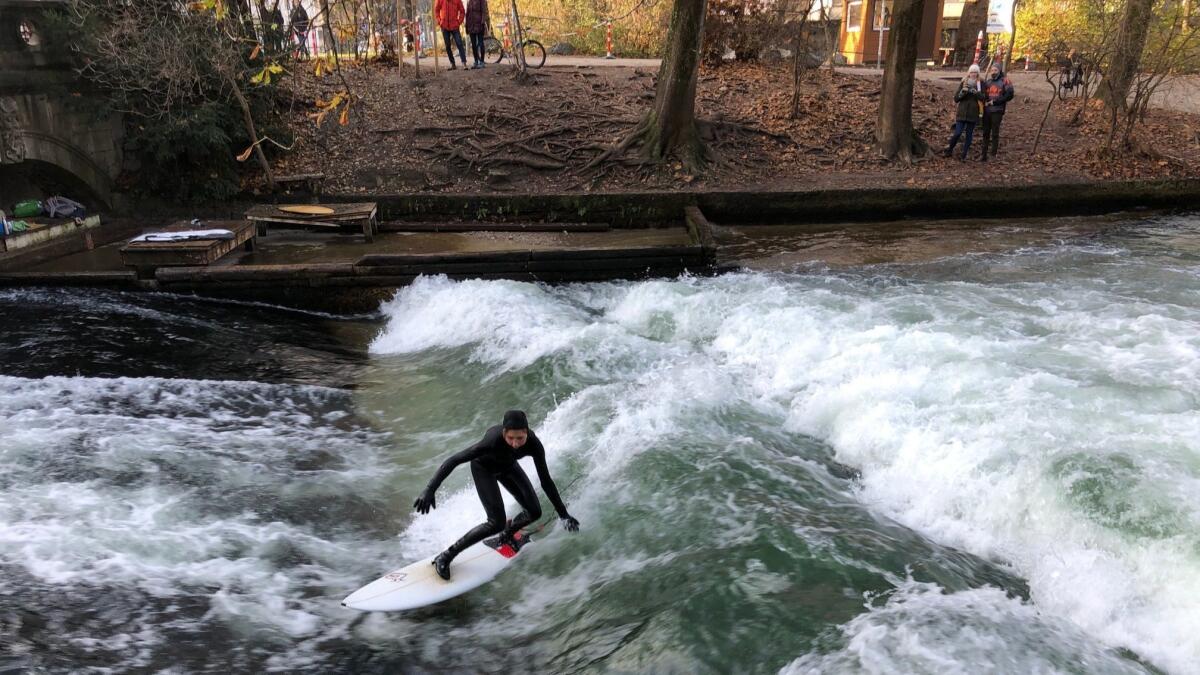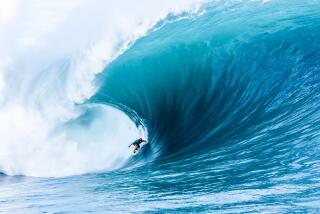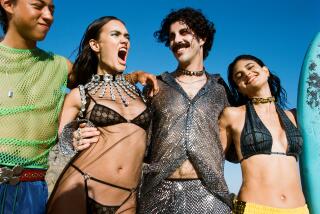It’s winter in landlocked Munich. Oktoberfest is a distant memory. But surf’s up!

- Share via
Reporting from Munich — You can hear the roar of rushing water from blocks away. Carried through the frigid December air, it overpowers the traffic noise in Munich, Germany’s third-largest city.
Drawing closer, you begin to hear faint, unintelligible shouting.
The sound is coming from the Eisbach — the name literally means “ice creek” — where people in wetsuits were happily taking turns surfing one at a time on a stationary, 4-foot-high wave.
More than 400 miles from the nearest ocean and half a year away from Munich’s ephemeral summer, these freshwater surfers seemed as oblivious to the bone-numbing cold as they were to the crowds of curious sightseers watching with a mixture of awe, admiration and perhaps a bit of sympathy.
Some of the hardiest of the surfers whooped and shrieked as they jumped from the sides of the river wave onto their bobbing boards. They zigged and zagged with varying degrees of expertise in front of the wave that extended almost all the way across the 40-foot-wide river. Some were performing elegantly and gallantly for the adoring crowd; others seemed to be happy to be able to hold on for just a few seconds. Yet it never seemed to take long before even the most dexterous of the dozen or so riders taking part in the early-morning session succumbed to exhaustion or to the incessant forces of the roiling waters.
After adroit rides that ranged from a few seconds of joy to longer moments of glory, they all inevitably disappeared under the crush of white water along with the surfboards attached to their ankles before popping up a few dozen yards downstream. They paddled to the river bank, beaming despite the bitter conditions, and got back in line for another ride.

“It is really cold but there’s hardly anyone out here in the winter so you don’t have to wait very long for the next ride, and that more than makes up for the cold,” Xaver Strambach, a 25-year-old electrical engineering student in Munich, said between rides. “That’s why it’s so special now. You have to wait up to 45 minutes on line for a ride in the summer. I live just around the corner from here so if I get really cold I can get home fast for a warm shower.”
Strambach, who surfs on the river before classes at least twice a week all winter long, explained how he started surfing in the Atlantic Ocean two years ago while on vacation in France and spent two weeks last summer surfing in the Pacific with a friend from Playa Vista. Ocean surfing is great, he said, but the Atlantic is a 12-hour drive and Los Angeles is a 12-hour flight.
“You make the most of what you have,” he said, as snowflakes drifted through the air. “If you live near the ocean, that’s where you surf. If you live in Munich, you come here.”
River surfing, he added, is different. “In the ocean, you wait and wait for the perfect wave and it’s great when you finally get one,” he said. “But here you just have to wait on the side until it’s your turn. In a way, it’s like riding a dirt bike off-road versus riding a motorcycle on a racetrack. River surfing is like a racetrack. The water is coming at you at high speed but it’s constant and the conditions are almost always the same.”
The Eisbach is a 1-1/4-mile spur of the Isar River that runs through the English Garden, Munich’s central park. A concrete weir and wooden planks dropped into the fast-flowing Eisbach to prevent erosion created the turbulent curl that surfers have been riding since 1965.
Surfing on the Eisbach was long forbidden, in large part because of the dangers involved. Locals recall the strange sight of police chasing surfers, boards under their arms, through the park in the 1970s. Surfing on the river was gradually tolerated before it was finally legalized in 2010 — in part because it had become such a popular tourist magnet for the city.
Because those concrete obstacles lurk ominously beneath the surface, riding the Eisbach can indeed be treacherous — even when it’s not freezing cold. Injuries ranging from scrapes to bruises, broken bones and even concussions are not uncommon. Beginners are strongly discouraged from even trying it. Those who have mastered the Eisbach warn newcomers to make sure they fall as flat as possible when their time on the wave is up.
“It can be really tricky with the concrete beneath the wave,” said Guenther Metzer, a 63-year-old retired engineer sporting a three-day gray beard. He said he tries to get out to the river three or four times a week all winter long — also his favorite time of the year to surf because of the reduced waiting times. “I broke my wrist a few years ago and have gotten some pretty bad bruises. It’s too much fun to stop now.”

Thomas Neumann, a 41-year-old anesthesiologist, also tries to make sure he gets in at least two or three surfing sessions a week — before work, during his lunch break or in the evening after work — despite some serious cuts and bruises over the years.
“If you’ve got a good wetsuit on and are bundled up tightly, it doesn’t really feel cold at all,” said Neumann. “The only thing exposed is your face, and it feels like a cold smack the first couple of times you fall in. But you’re always moving out there and you get used to it.”
Neumann began surfing about 20 years ago on a trip to Australia and has been hooked ever since. He went surfing over the decades on vacations whenever he could to such places as the Canary Islands or off the coast of Portugal. But now, with a family and two children ages 5 and 2, Neumann said it was hard to justify spending all his six weeks’ vacation each year surfing in faraway places.
“It was becoming extremely difficult with kids to keep up the ocean surfing thing,” he said. “All the good places are like a 16 hours’ drive away. So I started coming to the Eisbach. Now I like it so much here that I don’t want to go anywhere else to go surfing.”
Because it gets dark in Munich in December at 4 p.m., Neumann and some of his fellow surfers came up with a solution to lengthen the shortened day: They bring portable LED spotlights that are typically used at construction sites to illuminate the river until late at night.
“The spotlights work great,” he said. “The traffic lights help a little too. I just set up my two 50-watt LED spotlights on the bridge and you can see all you need to see with them. I’ve been out here until midnight and once even until 1 a.m. It’s just so much fun you don’t know when to stop.”
Kirschbaum is a special correspondent.
More to Read
Sign up for Essential California
The most important California stories and recommendations in your inbox every morning.
You may occasionally receive promotional content from the Los Angeles Times.










